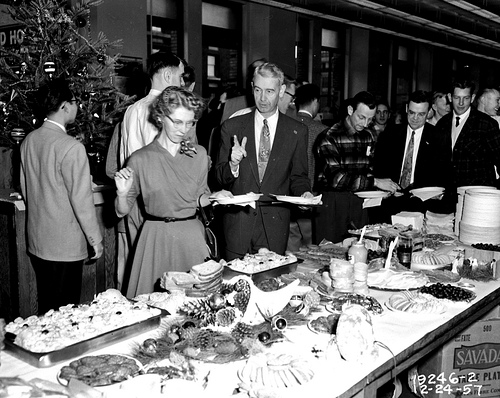Writers’ lore states that though writing for publication is a challenge, the bigger challenge is in promoting your published work: getting sales and readers. Without the support or contacts of a big publishing house, promoting your work as a self-published writer surely has to be harder. I imagine self-published writers as lone hitchhikers, holding their thumbs up along the shoulder of the information superhighway, trying to get noticed.
They say that social networks of the digital kind are crucial to getting picked up. Yet apart from ‘Don’t spam,’ solid tips on promoting your work this way are absent.
I confess that Twitter – and how to approach it – puzzled me for quite a while. But I think I get it now: Twitter is just one big party. Thus, when promoting your work on twitter, party etiquette applies.
1. Don’t stay in your clique or be anti-social
The day I published my article I sent out a tweet with a link:
My long form essay about my experience in Japan is now available to download on Amazon http://www.amazon.com/dp/B007F8M7Y2
Are you still awake?! Apart from its dearth of worthwhile prose this tweet failed because it was addressed only to friends who knew what, ‘my experience in Japan’ actually meant. I didn’t specify the topic of the essay. Had anyone retweeted it (they didn’t) it would have been meaningless to others. It was the same as going to a party and only hanging out with people I knew.
Tweets promoting your work must be able to be understood and accessible by complete strangers.
2. Be charming and interesting
A few days later I tweeted again:
'After Shock', Experiencing the 2011 Japanese earthquake http://www.amazon.com/dp/B007F8M7Y2 #longreads
This at least referred to the topic of my essay - but the writing is still dull as! I had over 6,000 words which I’d laboured over. Yet all I did was tweet the title (a title which I now regret). A pull-quote from the article may have piqued more curiosity. I did better with this one but it’s still lame:
One week until the anniversary of the disaster in Japan. I remember the experience in my essay, 'After Shock' http://www.amazon.com/dp/B007F8M7Y2 Please RT
Hah! ‘Please RT’ (retweet) I’m not surprised that only four friends did.
Tweets promoting your work are as important as your article’s opening line. Make those tweets take potential readers right into what you are writing about. Take it as seriously as your lead.
3. Be polite
After a few days I used hashtags and included @ handles of people and organisations that I thought would be interested in my topic. Here’s one I sent to the US Ambassador in Japan:
@AmbassadorRoos I was in Sendai 3/11. I thought you & your followers might be interested in my essay http://www.amazon.com/dp/B007F8M7Y2 よろしくおねがいあします
[This last part in Japanese roughly translates a classic Japanese saying, ‘Please be good to me.’]
Had I been at a party, I’m not sure I would have walked up to Ambassador Roos and said ‘Oh Hai! Can you promote my essay? Thanks! Please be good to me!’ and then walked away. I would introduce myself. I would take the time to learn a bit about him. I might comment on things we had in common. And once I develop that rapport I would mention my essay and ask Ambassador Roos what suggestions he had on how I could promote it.
Before you send a tweet to a stranger make sure you’re approaching them the way you would in person. Don’t barrel right in. Start a dialogue.
4. Make introductions and join conversations
A part of the challenge of using Twitter is getting a sufficient number of followers who are interested in your work and will help you promote it. You can do this using Twitter search (http://search.twitter.com). Search for keywords relevant to your work or knowledge then:
- See what strangers are tweeting about and join their conversation.
- Find people who are asking questions and answer them (or refer them to another twitterer/writer/subject matter expert who can [including @ handles]).
This is a great way to meet interesting people whom you might never have met otherwise!
Introduce people who have something in common, and when you hear people talking about something you are interested in, join the conversation.
5. Avoid boors and don’t become one
It's one thing to follow sources for news, information and entertainment. But just like at a party, there are occasionally people who monopolise the conversation. I have a few people that I follow who follow me back. This reciprocal arrangement can be nice. But beware of being a followee among hundreds (or thousands).
Tweeps who follow hundreds of people are generally boors. They follow anyone (and everyone) only because they want to be followed . When someone with a huge number of followers follows me I seldom follow back. Most of the time they’re only interested in their agenda. They don’t read tweets – they just write them. (How could they read those hundreds of tweets each day?!).*
Conversely, be thoughtful about who and how you follow others. Don’t ask your followers to retweet then not return the favour. Don’t expect them to read your tweets while blissfully ignoring theirs.
Avoid bores and don’t become one: read tweets, respond to tweets - engage with your followers and those you follow.
So, remember to twitiquette as to etiquette.


